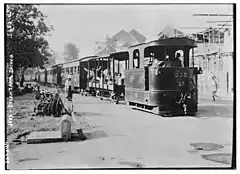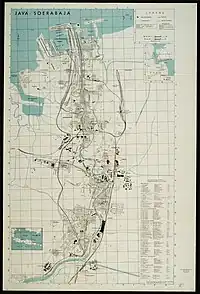| Trams in Surabaya | |||
|---|---|---|---|
_TMnr_10014818.jpg.webp) An electric tram passed through a street in Surabaya | |||
| Operation | |||
| Locale | Surabaya | ||
| Open | 1889 | ||
| Close | 1978 | ||
| Status | Closed | ||
| Owner(s) | Kereta Api Indonesia (assets) | ||
| Operator(s) | Oost-Java Stoomtram Maatschappij (1889–1949) Kereta Api Indonesia (1949–1978) | ||
| Infrastructure | |||
| Track gauge | 1,067 mm (3 ft 6 in) | ||
| |||
There was a tram system in Surabaya, East Java, Indonesia from 1889 to 1978. The tramway was operated by a private company Oost-Java Stoomtram Maatschappij (OJS, "East Java Steam Tram Company"), and later by Kereta Api Indonesia (KAI), and was the only OJS-owned rail system survived in post-independence Indonesia. The tramway linked Ujung (Port of Tanjung Perak) with Wonokromo and continued towards Krian in Sidoarjo. All land assets of the tramway is currently owned by Operational Area VII Surabaya of the KAI.
History
As the initial capital of the company, the OJS started to build a steam-powered tram line in Surabaya in 1889. The first section, Ujung–Fort Prins Hendrik, was inaugurated in 10 December 1889.[1] The line mostly runs along the banks of Mas River.
In early 20th century, the OJS was interested in the Bataviasche Elektrische Tram Maatschappij (BETM) success in developing electric trams in Batavia. To prepare for electric tram installation, in 1911 the OJS expanded its network so that almost the entire city of Surabaya was connected by tram lines. It reached 36 kilometers of length as of 1924.[2][3] The electric tram system was officially opened in 15 May 1923.[4]
During expansion, the main line was completely overhauled; the route that previously passed through the banks of Mas River was diverted through the city center, running past Pasar Turi and Sawahan and followed Darmo Street in the city center. Other lines built are the Simpang–Wonokromo Kota, Simpang–Gubeng, Tunjungan–Sawahan, and Simpang–Kalimas. To support tram maintenance, a tram depot and a power plant were also built in Sawahan.[5] However, during the Japanese occupation the Karangpilang–Krian OJS section was finally scrapped by Japanese rōmusha workers along with all OJS lines outside Surabaya. Although the tram stop names were recorded in the data, they were unable to save the tracks and stops from their dismantling.[6]
The tram network was nationalized and operated by DKARI (currently KAI) in 1949.[5] The electric tramway was dismantled in late 1960s, and the remaining steam tramway was finally closed in 1978.[7][8][9]
Line sections
These are the tramway sections in Surabaya according to the book Buku Jarak Antarstasiun dan Perhentian by the KAI.
| Line | Length |
|---|---|
| Ujung–Wonokromo Kota–Krian OJS | 13.2 km |
| Wonokromo Kota–Willemplein (Jembatan Merah) | 8.4 km |
| Willemplein–Tanjung Perak | 4,9 km |
| Simpang branch for Surabaya Gubeng Station | 0.2 km |
| Boulevard–Palmerah branch | 2 km |
| Tunjungan–Sawahan | 2.6 km |
Gallery
 Wonokromo Kota tram station in 2020, located not too far from the counterpart train station
Wonokromo Kota tram station in 2020, located not too far from the counterpart train station A steam tram pulled by OJS No. 27 locomotive
A steam tram pulled by OJS No. 27 locomotive
See also
References
- ↑ Oost-Java Stoomtram Maatschappij (1902). Verslag der Oost-Java Stoomtram Maatschappij. Den Haag: OJS.
- ↑ Freek., Colombijn; Joost., Coté; Joost., Cote⁺ѓ (2014). Cars, conduits, and kampongs the modernization of the Indonesian city, 1920-1960. Leiden: BRILL. ISBN 978-9004280724. OCLC 894170623.
- ↑ "Oost Java Stoomtram Maatschappij". searail.malayanrailways.com. Retrieved 23 February 2018.
- ↑ Nasution (2006). Ekonomi Surabaya pada masa kolonial, 1830-1930. Surabaya: Pustaka Intelektual. ISBN 9792506802. OCLC 80717765.
- 1 2 "Jejak dan sosok di balik trem Surabaya - Ayorek!". Ayorek! (in Indonesian). 2013-07-08. Archived from the original on 2018-07-21. Retrieved 2018-07-21.
- ↑ Nusantara., Tim Telaga Bakti; Indonesia., Asosiasi Perkeretaapian (1997). Sejarah perkeretaapian Indonesia (Cet. 1 ed.). Bandung: Angkasa. ISBN 9796651688. OCLC 38139980.
- ↑ okler.net. "Heritage - Kereta Api Indonesia". heritage.kai.id. Retrieved 20 July 2018.
- ↑ "Java's Steam Tram Locomotives in the 1970s". www.internationalsteam.co.uk. Retrieved 20 July 2018.
- ↑ Raap, Olivier Johannes (2017). Kota di Djawa Tempo Doeloe. Jakarta: Gramedia Pustaka Utama. p. 184.
